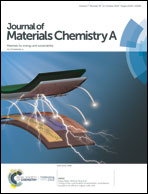A high-capacity organic anode with self-assembled morphological transformation for green lithium-ion batteries†
Abstract
Renewable lithium-ion batteries based on green organic lithium storage materials are of great significance for sustainable development of new power sources. Herein, itaconic acid, with two active carboxyl groups and a conjugated double bond, is proposed for lithium storage purposes. During electrode processing with carboxymethyl cellulose sodium and styrene butadiene rubber binders, itaconic acid assembles into a leek-like morphology composed of ultrathin micro-ribbons. Self-assembled morphological transformation from the leek-like ribbon to an amorphous state and finally to micro-spheres at different electrochemical states is observed. It is capable of reacting reversibly with six lithium ions per formula unit, exhibiting the first reversible capacity of 1270 mA h g−1. Moreover, the first coulombic efficiency, rate capability and cycling stability are superior to those of most of the reported organic materials. The underlying mechanisms of lithiation and de-lithiation are discussed through a combination of electrochemical and spectroscopic studies.



 Please wait while we load your content...
Please wait while we load your content...